Is it OK not to have curtains in a living room?
Yes, if:
Privacy isn’t a concern (e.g., upper floors, remote locations).
You prefer alternatives: motorized shades, frosted glass, or shutters.
The room has bold architectural features (e.g., exposed beams).
Is it OK to sleep with no curtains?
Not ideal:
Light pollution disrupts sleep cycles.
Privacy risks in ground-floor bedrooms.
Solution: Install blackout roller shades or lightweight linen curtains.
Why do curtains look cheap?
Thin fabric: Flimsy polyester that wrinkles.
Poor fit: Too short/wide for the window.
Shiny finishes: Plastic-like sheen.
Mismatched hardware: Clunky rods in delicate spaces.
What makes a curtain look expensive?
Weight: Heavy linen or velvet drapes.
Details: Hand-sewn pleats, French seams.
Hardware: Matte black or brass rods.
Fullness: Fabric width = 2x window width.
Brand Spotlight: Foulola’s weighted hems and structured headers mimic couture drapery.
Is it okay if curtains don’t touch the floor?
Yes, strategically:
Sill-length: ½ inch above the sill for kitchens.
Floodwater hem: 1 inch above floor (modern, pet-friendly).
Avoid: Mid-wall lengths—they cut rooms awkwardly.
What face shape do curtains suit?
While face shape isn’t relevant, window shape dictates curtain styles:
Arched windows: Cascading sheers or tailored valances.
Bay windows: Flexible track systems.
Square windows: Floor-length panels for vertical emphasis.
Key Take aways
Luxury Illusion: Fullness + heavy fabric = hotel-worthy drapes.
No-Curtain Fix: Use smart tinting or stained glass for privacy.
Architectural Harmony: Match curtain length to window proportions.





